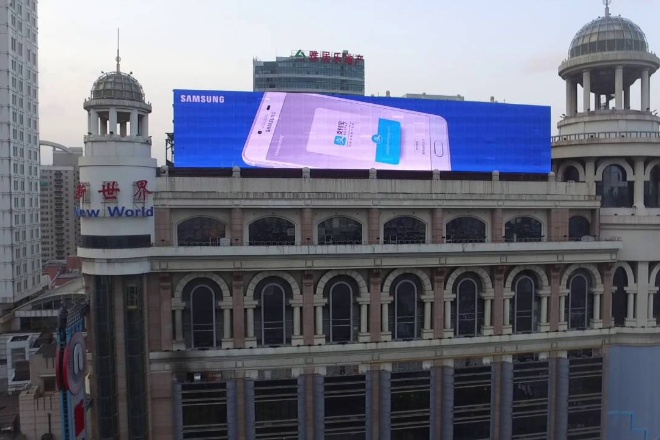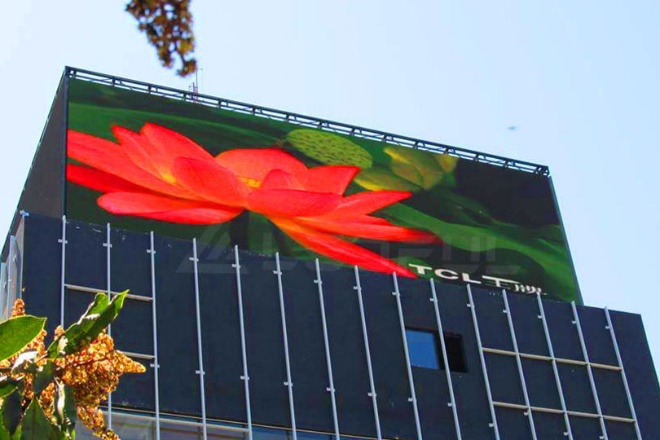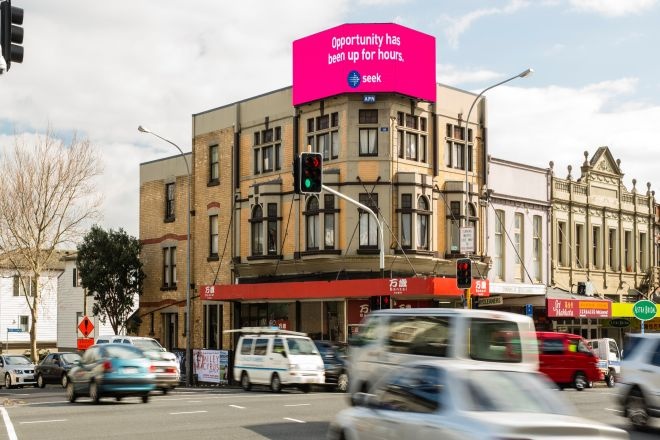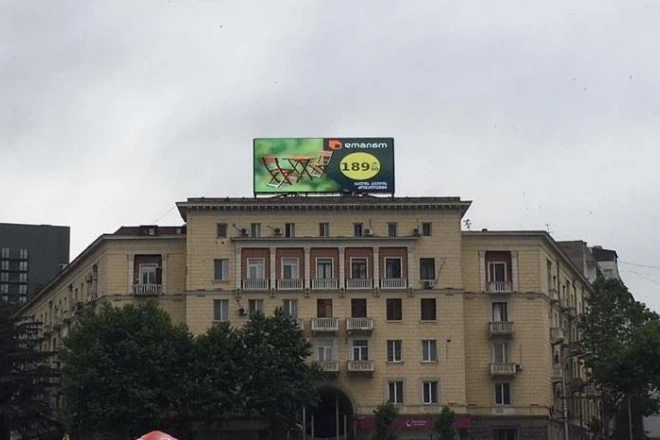소개

Nowadays, many 발광 다이오드 표시 스크린 are installed on rooftops because the high-altitude view and wide influence of the rooftop have become a key platform for information dissemination in modern cities.
However, the harsh environment of the rooftop places extremely high demands on the performance of the LED display. This article will talk in detail about the special requirements for LED displays installed on the rooftop.
1. Structural and design requirements for LED displays

When we talk about installing LED displays on the rooftop, it is not just a matter of putting the screen up.
The rooftop environment is complex and changeable, with strong winds, many vibrations, and possible extreme weather, so the structure and design of the display must withstand these tests. Next, let’s talk about some specific requirements in this regard.
1). Stable structural design:
- The foundation must be laid firmly:
If the foundation is unstable, the LED display is very likely to fall, which is very dangerous. Therefore, before installation, you must conduct a good geological survey to see if the foundation can withstand the weight of the display.
The foundation type must also be selected correctly, such as concrete foundation or pile foundation, so as to ensure that the display screen is stable.
- Wind load and magnitude must be considered:
The roof is windy, and sometimes there will be earthquakes, so the display screen must be able to withstand these.
You have to calculate the wind load and magnitude according to the local wind speed, wind direction, and earthquake conditions to ensure that the LED display screen structure can remain stable under these extreme conditions.
- The module design is particular:
In order to make the display screen more wind-resistant, you can design the module to be inclined at 8° or with a slight tilt angle so that the wind cannot blow it away. At the same time, the connection between the modules must also be reinforced to prevent loosening when the wind is strong or vibrating.
2). Lightweight and transparent design:
- Lightweight design to reduce the burden:
LED display screens are so heavy that the roof may not be able to withstand it. Therefore, you have to choose some lightweight and high-strength materials, such as aluminum alloy and carbon fiber, to make the LED display screen lighter.
At the same time, you can further reduce the weight by optimizing the structural design, such as using a hollow structure and honeycomb structure.
- Transparent design, both practical and beautiful:
The wind on the roof is strong. If the display screen is too dense, the wind resistance will be large, which is not good for the stability of the display screen. Therefore, you can adopt a transparent design, such as a grid-like, hollowed-out design, so that the wind can pass through and reduce the wind load.
Moreover, the transparent design can also make the display screen look more beautiful and enhance the overall visual effect. Of course, the convenience of maintenance cannot be ignored. It is necessary to ensure that maintenance personnel can easily enter for inspection and maintenance.
2. Requirements for environmental adaptability of LED display screens
1). Waterproof and dustproof:
- High waterproof and dustproof level:
If the LED display screen is not waterproof and dustproof, then on rainy days and dusty days, won’t the LED screen “strike”?
Therefore, the display screen must have a high waterproof and dustproof level, such as IP65, so as to effectively prevent rain and dust from entering the screen and ensure that the “lifeline” of the display screen is not threatened.
- Sealing treatment of seams and joints:
Don’t underestimate those seams and joints; they are the “weak links” that are waterproof and dustproof. Therefore, these parts must be specially sealed, such as using waterproof strips, sealing pads, etc., to ensure that the waterproof and dustproof effects are impeccable.
2). Weather resistance:
- Can work normally in harsh environments:
The LED display must be an “all-around warrior” that can cope with high temperature, low temperature, or humid environment. This requires that the display take these harsh conditions into consideration when designing to ensure that it can normally work in various environments without “falling off the chain.”
- Select industrial-grade integrated circuit chips:
The chip is the “brain” of the display, so you have to choose a better one. In order to cope with harsh environments, we have to choose industrial-grade integrated circuit chips with a wide operating temperature range.
In this way, no matter how the environment changes, the LED display can maintain stable operation without “strike” or “stuck.”
- Other auxiliary measures:
In addition to choosing good chips, other auxiliary measures must be taken to enhance the weather resistance of the LED display. For example, a heat dissipation system can be installed to ensure that the display will not overheat in a high-temperature environment, or a moisture-proof design can be used to prevent the humid environment from damaging the display.
3. Safety and protection requirements for LED display screens

As an important carrier of modern information display, LED display screens should not only pursue the ultimate in display effects but also be foolproof in terms of safety and protection. After all, safety is the first priority.
Next, let’s talk about the requirements for the safety and protection of LED display screens, especially lightning protection and surge protection, grounding, and equipotential connection.
1). Lightning protection and surge protection:
- Install lightning protection devices and lightning arresters:
Lightning and surge are the “big enemies” of LED display screens, and the display screen may be “injured” if you are not careful.
Therefore, we have to install lightning protection devices and lightning arresters on the display screen, just like holding up a “protective umbrella” for the display screen to prevent lightning strikes and overvoltage from damaging the display screen.
- Select a stable and reliable power supply:
The power supply is the “heart” of the LED display screen, so you have to choose a better one. Not only must it be stable and reliable, but lightning protection and surge protection design must also be considered.
In this way, even if we encounter severe weather conditions or power grid fluctuations, the display screen can be “as stable as an old dog” and continue to bring us wonderful displays.
2). Grounding and equipotential connection:
- 좋은 접지:
The main body and shell of the LED display must be well grounded, which is a basic requirement for safety. The grounding resistance must be less than 3 ohms to ensure reliable grounding and prevent safety problems caused by poor grounding.
- Equipotential connection:
Equipotential connection is a “high-tech” thing. It can connect the “little guys,” such as the metal shell, cable sheath, and metal frame in the LED display, to the grounding device to achieve equipotential.
In this way, even if lightning wants to pass through cables or metal components, it will be “blocked” by the equipotential connection, thereby protecting the display from damage.
- 정기 검사 및 유지 관리:
Safety and protection are not a one-time thing, and regular inspection and maintenance are required.
For example, regularly check whether the grounding resistance is qualified, whether the lightning protection device and lightning arrester are intact, and whether the cables and metal components are worn or corroded.
Only in this way can the safety and protection measures of the display be ensured to be always effective.
4. Requirements for optical performance and visual effects
1). 명도 and contrast adjustment:
When installing an LED display on the top floor, ambient light is a big challenge. During the day, the sun is shining directly, but at night, it may be too dark to see clearly. However, the LED display is smart.
It can automatically adjust the brightness according to the ambient light, just like your eyes. It can brighten when it is dark and dim when it is bright. In this way, you can see a clear and comfortable picture, whether it is day or night.
Moreover, its contrast is also super high. Just imagine that black is shiny black and white is dazzling white. The picture is full of layers, and the details are clearly visible. Behind this, it is inseparable from high-quality LED lamp beads and precise display control systems.
The lamp beads are like small light bulbs, emitting pure and bright light; the display control system is like a brain, accurately controlling the brightness of each lamp bead to make the picture more vivid and realistic.
2). 시야각 optimization:
The viewing angle of the LED display installed on the top floor is a big question. After all, the audience may watch from all angles. However, the LED display is different. It can automatically adjust the installation angle according to your viewing position and height to ensure that you can see a clear picture no matter where you stand.
Especially the wide-angle design is simply great! It uses wide-angle LED lamp beads, like a small sun, to evenly spread light to every corner.
Coupled with the optimized display structure, such as curved screens or bendable screens, the picture fits your sight better. In this way, even on the top floor, you can enjoy a panoramic visual experience.
3). Anti-glare and light pollution control:
For LED displays installed on the top floor, glare and light pollution are a big problem. After all, when the lights are on at night, it may affect the surrounding environment and residents.
However, LED displays don’t do this. It uses anti-glare technology and materials, just like putting a layer of “protective clothing” on the screen to reduce the intensity of reflected light and make you more comfortable to watch.
Moreover, it will also conduct light pollution assessments and avoid light pollution caused by excessive brightness at night through an intelligent brightness adjustment system. In this way, you can enjoy a wonderful visual feast without disturbing others’ rest.
Especially the anti-glare technology, which is actually a special coating on the surface of the screen, just like applying a “sunscreen” to the screen. The layout of the LED lamp beads has also been carefully designed to ensure that the light will not be particularly glaring at a certain angle. In this way, the LED display screen installed on the top floor can let you enjoy a clear and comfortable viewing experience.
5. Installation and maintenance requirements of LED display screen

1). Professional installation:
First of all, the installation of LED display screens is not a simple job; it must be done by a professional team. These teams are strictly trained and are familiar with the structure and performance of the display screen.
When they are installed, they will strictly abide by the relevant safety regulations and operating procedures to ensure that every step is correct. In this way, the display screen is not only installed firmly but also safe and reliable to use.
You may think, isn’t it just installing a display screen, so why is it so complicated? In fact, there is a lot of knowledge in this. The weight of the display screen is not light, and the load-bearing problem must be considered during installation。
In addition, the circuit and interface of the display screen must be connected properly. Otherwise, it is easy to malfunction. These must be handled by a professional team.
2). Easy to maintain:
After the display screen is installed, the next thing to consider is the maintenance problem. After all, this display screen is not used once and is thrown away; it must be used for a long time. Therefore, the design of the display screen must take into account the convenience of maintenance.
First of all, the structure of the display screen must be designed reasonably so that maintenance personnel can easily carry out daily inspection and maintenance work. For example, sufficient maintenance space must be reserved on the back or side of the display screen so that maintenance personnel can easily disassemble and replace parts.
In addition, the circuits and interfaces of the display screen must also be designed to be easy to access and operate so that maintenance is more convenient.
In addition, a reasonable maintenance channel must be designed. Think about it: if the display screen is installed in a high place, how can maintenance personnel increase? Therefore, a safe channel must be designed, such as a ladder, scaffolding, etc., so that maintenance personnel can reach the location of the display screen safely and conveniently.
결론
In summary, the successful deployment of the rooftop LED display screen needs to comprehensively consider many factors, such as structural stability, environmental adaptability, visual optimization, convenient maintenance, intelligent control, and compliance.
With the continuous innovation of technology, we have reason to believe that the future rooftop LED display screen will be more intelligent, efficient, and environmentally friendly, not only adding brilliance to the city but also becoming an important force in promoting information dissemination and social progress.
마지막으로 LED 디스플레이에 대해 더 알고 싶으시다면, 우리에게 연락해주세요.
